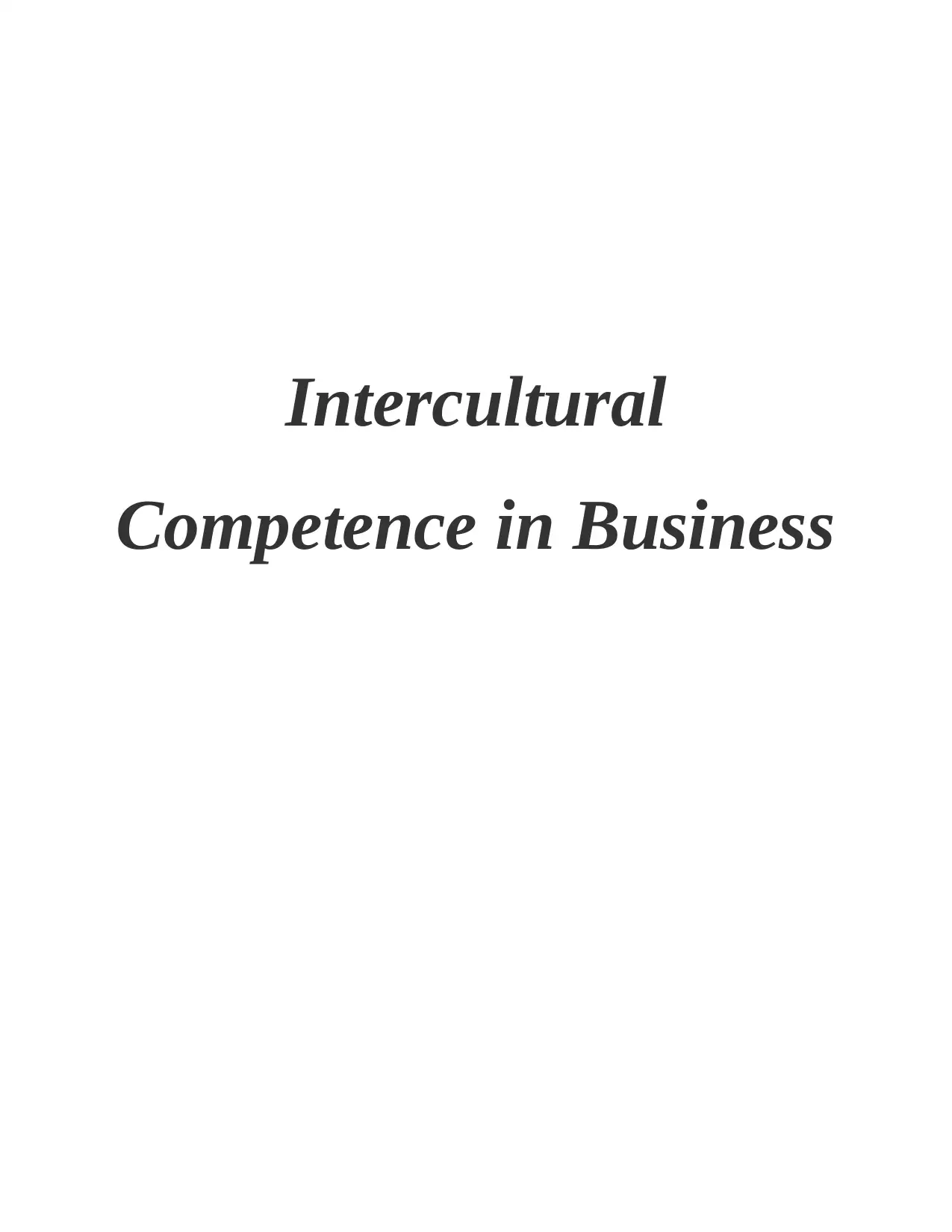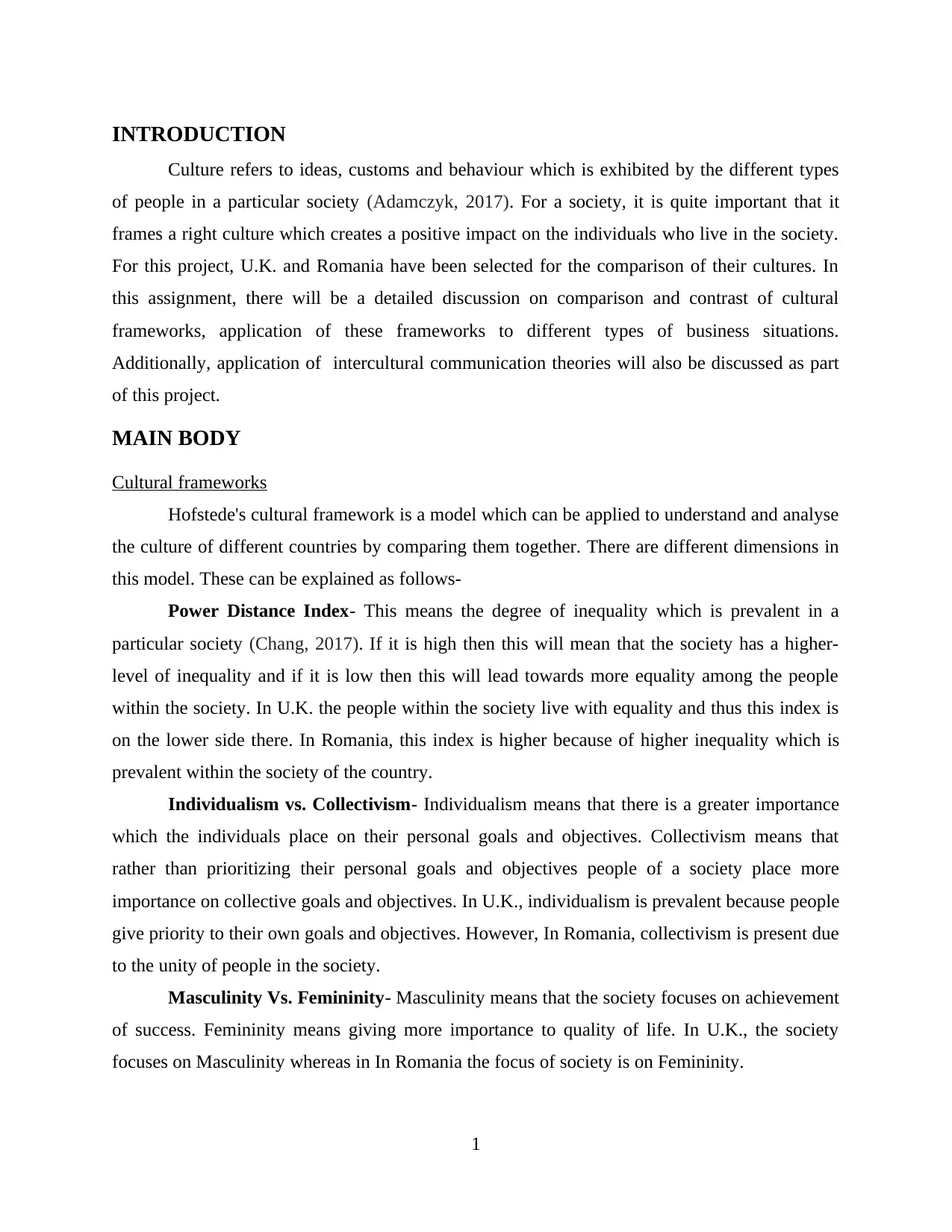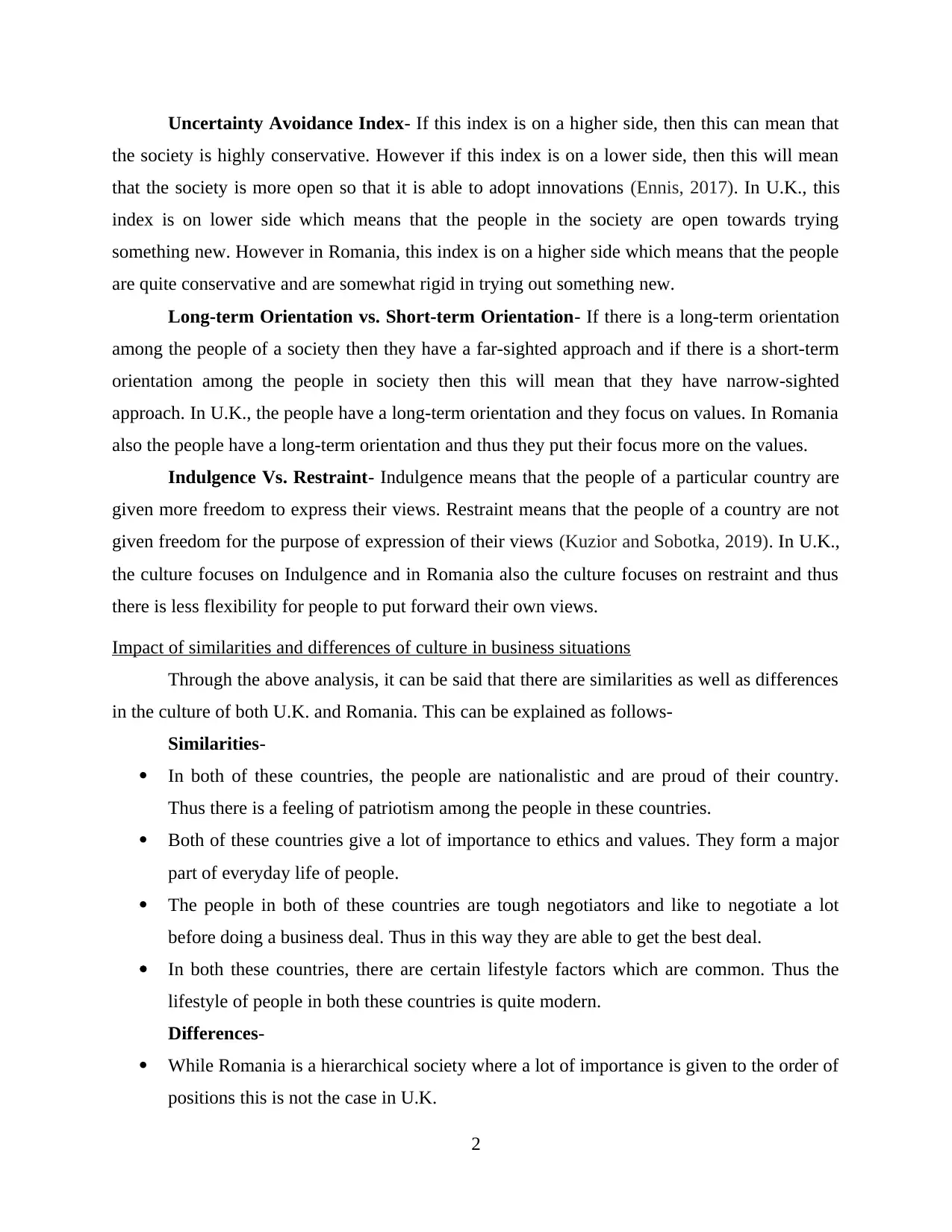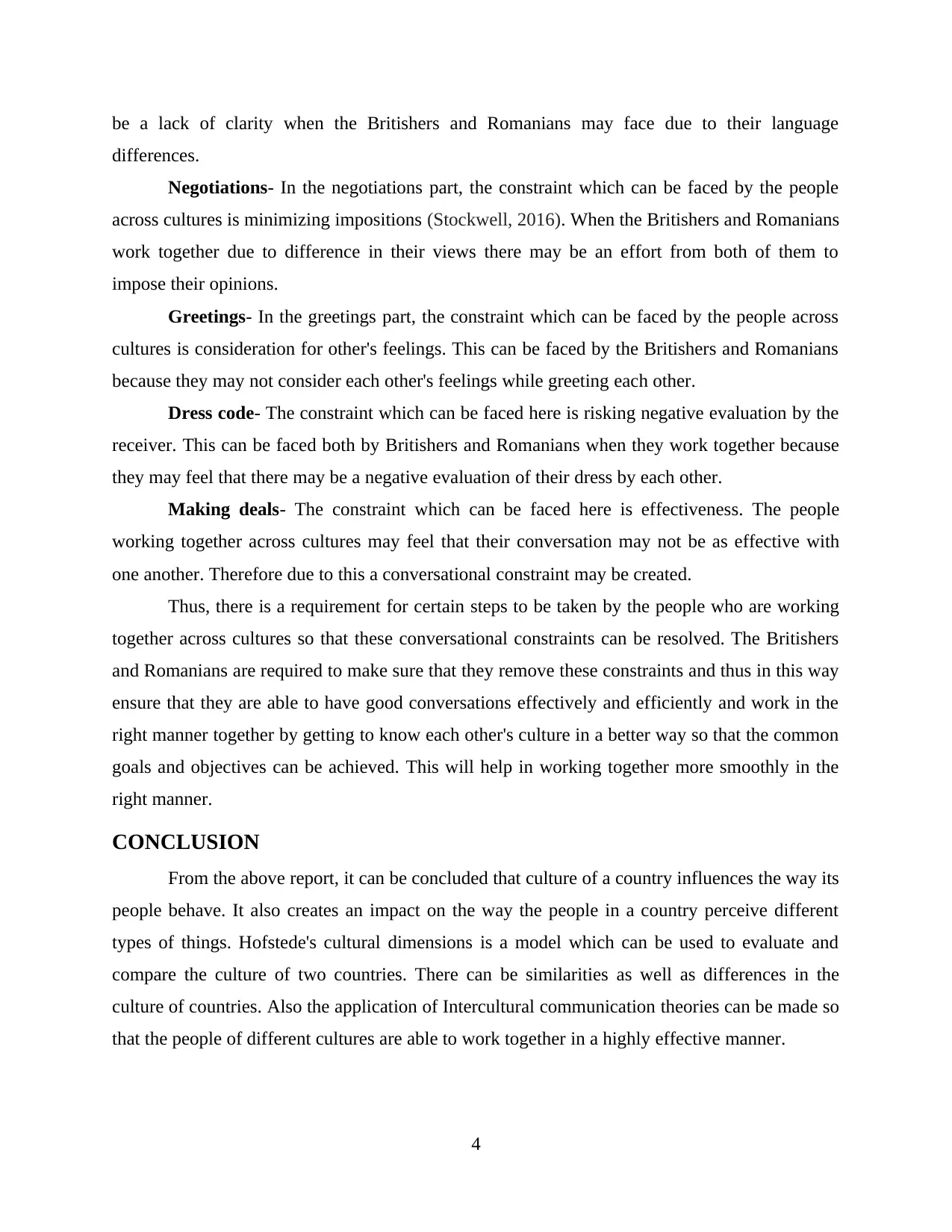Intercultural Competence in Business
VerifiedAdded on 2023/01/06
|7
|1913
|80
AI Summary
This assignment discusses the comparison and contrast of cultural frameworks, the impact of similarities and differences in culture on business situations, and the application of intercultural communication theories. The focus is on the cultures of the UK and Romania.
Contribute Materials
Your contribution can guide someone’s learning journey. Share your
documents today.

Intercultural
Competence in Business
Competence in Business
Secure Best Marks with AI Grader
Need help grading? Try our AI Grader for instant feedback on your assignments.

Table of Contents
INTRODUCTION...........................................................................................................................1
MAIN BODY...................................................................................................................................1
Cultural frameworks....................................................................................................................1
Impact of similarities and differences of culture in business situations......................................2
Application of Intercultural communication theories..................................................................3
CONCLUSION................................................................................................................................4
REFERENCES................................................................................................................................5
INTRODUCTION...........................................................................................................................1
MAIN BODY...................................................................................................................................1
Cultural frameworks....................................................................................................................1
Impact of similarities and differences of culture in business situations......................................2
Application of Intercultural communication theories..................................................................3
CONCLUSION................................................................................................................................4
REFERENCES................................................................................................................................5

INTRODUCTION
Culture refers to ideas, customs and behaviour which is exhibited by the different types
of people in a particular society (Adamczyk, 2017). For a society, it is quite important that it
frames a right culture which creates a positive impact on the individuals who live in the society.
For this project, U.K. and Romania have been selected for the comparison of their cultures. In
this assignment, there will be a detailed discussion on comparison and contrast of cultural
frameworks, application of these frameworks to different types of business situations.
Additionally, application of intercultural communication theories will also be discussed as part
of this project.
MAIN BODY
Cultural frameworks
Hofstede's cultural framework is a model which can be applied to understand and analyse
the culture of different countries by comparing them together. There are different dimensions in
this model. These can be explained as follows-
Power Distance Index- This means the degree of inequality which is prevalent in a
particular society (Chang, 2017). If it is high then this will mean that the society has a higher-
level of inequality and if it is low then this will lead towards more equality among the people
within the society. In U.K. the people within the society live with equality and thus this index is
on the lower side there. In Romania, this index is higher because of higher inequality which is
prevalent within the society of the country.
Individualism vs. Collectivism- Individualism means that there is a greater importance
which the individuals place on their personal goals and objectives. Collectivism means that
rather than prioritizing their personal goals and objectives people of a society place more
importance on collective goals and objectives. In U.K., individualism is prevalent because people
give priority to their own goals and objectives. However, In Romania, collectivism is present due
to the unity of people in the society.
Masculinity Vs. Femininity- Masculinity means that the society focuses on achievement
of success. Femininity means giving more importance to quality of life. In U.K., the society
focuses on Masculinity whereas in In Romania the focus of society is on Femininity.
1
Culture refers to ideas, customs and behaviour which is exhibited by the different types
of people in a particular society (Adamczyk, 2017). For a society, it is quite important that it
frames a right culture which creates a positive impact on the individuals who live in the society.
For this project, U.K. and Romania have been selected for the comparison of their cultures. In
this assignment, there will be a detailed discussion on comparison and contrast of cultural
frameworks, application of these frameworks to different types of business situations.
Additionally, application of intercultural communication theories will also be discussed as part
of this project.
MAIN BODY
Cultural frameworks
Hofstede's cultural framework is a model which can be applied to understand and analyse
the culture of different countries by comparing them together. There are different dimensions in
this model. These can be explained as follows-
Power Distance Index- This means the degree of inequality which is prevalent in a
particular society (Chang, 2017). If it is high then this will mean that the society has a higher-
level of inequality and if it is low then this will lead towards more equality among the people
within the society. In U.K. the people within the society live with equality and thus this index is
on the lower side there. In Romania, this index is higher because of higher inequality which is
prevalent within the society of the country.
Individualism vs. Collectivism- Individualism means that there is a greater importance
which the individuals place on their personal goals and objectives. Collectivism means that
rather than prioritizing their personal goals and objectives people of a society place more
importance on collective goals and objectives. In U.K., individualism is prevalent because people
give priority to their own goals and objectives. However, In Romania, collectivism is present due
to the unity of people in the society.
Masculinity Vs. Femininity- Masculinity means that the society focuses on achievement
of success. Femininity means giving more importance to quality of life. In U.K., the society
focuses on Masculinity whereas in In Romania the focus of society is on Femininity.
1

Uncertainty Avoidance Index- If this index is on a higher side, then this can mean that
the society is highly conservative. However if this index is on a lower side, then this will mean
that the society is more open so that it is able to adopt innovations (Ennis, 2017). In U.K., this
index is on lower side which means that the people in the society are open towards trying
something new. However in Romania, this index is on a higher side which means that the people
are quite conservative and are somewhat rigid in trying out something new.
Long-term Orientation vs. Short-term Orientation- If there is a long-term orientation
among the people of a society then they have a far-sighted approach and if there is a short-term
orientation among the people in society then this will mean that they have narrow-sighted
approach. In U.K., the people have a long-term orientation and they focus on values. In Romania
also the people have a long-term orientation and thus they put their focus more on the values.
Indulgence Vs. Restraint- Indulgence means that the people of a particular country are
given more freedom to express their views. Restraint means that the people of a country are not
given freedom for the purpose of expression of their views (Kuzior and Sobotka, 2019). In U.K.,
the culture focuses on Indulgence and in Romania also the culture focuses on restraint and thus
there is less flexibility for people to put forward their own views.
Impact of similarities and differences of culture in business situations
Through the above analysis, it can be said that there are similarities as well as differences
in the culture of both U.K. and Romania. This can be explained as follows-
Similarities-
In both of these countries, the people are nationalistic and are proud of their country.
Thus there is a feeling of patriotism among the people in these countries.
Both of these countries give a lot of importance to ethics and values. They form a major
part of everyday life of people.
The people in both of these countries are tough negotiators and like to negotiate a lot
before doing a business deal. Thus in this way they are able to get the best deal.
In both these countries, there are certain lifestyle factors which are common. Thus the
lifestyle of people in both these countries is quite modern.
Differences-
While Romania is a hierarchical society where a lot of importance is given to the order of
positions this is not the case in U.K.
2
the society is highly conservative. However if this index is on a lower side, then this will mean
that the society is more open so that it is able to adopt innovations (Ennis, 2017). In U.K., this
index is on lower side which means that the people in the society are open towards trying
something new. However in Romania, this index is on a higher side which means that the people
are quite conservative and are somewhat rigid in trying out something new.
Long-term Orientation vs. Short-term Orientation- If there is a long-term orientation
among the people of a society then they have a far-sighted approach and if there is a short-term
orientation among the people in society then this will mean that they have narrow-sighted
approach. In U.K., the people have a long-term orientation and they focus on values. In Romania
also the people have a long-term orientation and thus they put their focus more on the values.
Indulgence Vs. Restraint- Indulgence means that the people of a particular country are
given more freedom to express their views. Restraint means that the people of a country are not
given freedom for the purpose of expression of their views (Kuzior and Sobotka, 2019). In U.K.,
the culture focuses on Indulgence and in Romania also the culture focuses on restraint and thus
there is less flexibility for people to put forward their own views.
Impact of similarities and differences of culture in business situations
Through the above analysis, it can be said that there are similarities as well as differences
in the culture of both U.K. and Romania. This can be explained as follows-
Similarities-
In both of these countries, the people are nationalistic and are proud of their country.
Thus there is a feeling of patriotism among the people in these countries.
Both of these countries give a lot of importance to ethics and values. They form a major
part of everyday life of people.
The people in both of these countries are tough negotiators and like to negotiate a lot
before doing a business deal. Thus in this way they are able to get the best deal.
In both these countries, there are certain lifestyle factors which are common. Thus the
lifestyle of people in both these countries is quite modern.
Differences-
While Romania is a hierarchical society where a lot of importance is given to the order of
positions this is not the case in U.K.
2
Secure Best Marks with AI Grader
Need help grading? Try our AI Grader for instant feedback on your assignments.

The people of Romania are comparatively more conservative in their outlook as
compared to U.K. where people are not so conservative.
There is a more use of a formal approach in the everyday life in U.K. as compared to
Romania where there can be a use of an informal approach also.
While in U.K., English is the official language. In Romania, Romanian is the official
language.
These similarities and differences have an impact on the people working across cultures because
there may be an impact created by them on various types of business situations. It is explained in
detail as follows-
Impact of similarities and differences on Business situations-
Management- In the management part of business, both the Britishers and the
Romanians will be able to enjoy working together because of the similarity of presence of ethics
and values in both of these countries.
Negotiations- Both the Britishers and Romanians are known to be tough negotiators.
Thus both of them will enjoy working together due to this particular similarity.
Greetings- As both Britishers and Romanians provide importance to their ethics and
values they ensure that they give proper greetings to each other when they meet either for formal
meeting or informal meeting.
Dress Code- Since the people of U.K. focus more on adopting a formal approach due to
this they will focus on wearing a formal dress code in the business meetings. While the people in
Romania focus on adopting an informal approach and thus their focus may not be put on a
formal dress code in the business meetings.
Application of Intercultural communication theories
Conversational Constraints Theory- This theory identifies the constraints which are
faced by people of different cultures when they have a conversation with each other (Murray,
2016). This theory can be used to identify the best way through which effective communication
can be done by the people of different cultures. It can be applied to the following business
situations-
Management- In the management situation, the biggest constraint which the people
conversing across cultures can face is clarity (Petrovskaya and Shaposhnikov, 2020). There may
3
compared to U.K. where people are not so conservative.
There is a more use of a formal approach in the everyday life in U.K. as compared to
Romania where there can be a use of an informal approach also.
While in U.K., English is the official language. In Romania, Romanian is the official
language.
These similarities and differences have an impact on the people working across cultures because
there may be an impact created by them on various types of business situations. It is explained in
detail as follows-
Impact of similarities and differences on Business situations-
Management- In the management part of business, both the Britishers and the
Romanians will be able to enjoy working together because of the similarity of presence of ethics
and values in both of these countries.
Negotiations- Both the Britishers and Romanians are known to be tough negotiators.
Thus both of them will enjoy working together due to this particular similarity.
Greetings- As both Britishers and Romanians provide importance to their ethics and
values they ensure that they give proper greetings to each other when they meet either for formal
meeting or informal meeting.
Dress Code- Since the people of U.K. focus more on adopting a formal approach due to
this they will focus on wearing a formal dress code in the business meetings. While the people in
Romania focus on adopting an informal approach and thus their focus may not be put on a
formal dress code in the business meetings.
Application of Intercultural communication theories
Conversational Constraints Theory- This theory identifies the constraints which are
faced by people of different cultures when they have a conversation with each other (Murray,
2016). This theory can be used to identify the best way through which effective communication
can be done by the people of different cultures. It can be applied to the following business
situations-
Management- In the management situation, the biggest constraint which the people
conversing across cultures can face is clarity (Petrovskaya and Shaposhnikov, 2020). There may
3

be a lack of clarity when the Britishers and Romanians may face due to their language
differences.
Negotiations- In the negotiations part, the constraint which can be faced by the people
across cultures is minimizing impositions (Stockwell, 2016). When the Britishers and Romanians
work together due to difference in their views there may be an effort from both of them to
impose their opinions.
Greetings- In the greetings part, the constraint which can be faced by the people across
cultures is consideration for other's feelings. This can be faced by the Britishers and Romanians
because they may not consider each other's feelings while greeting each other.
Dress code- The constraint which can be faced here is risking negative evaluation by the
receiver. This can be faced both by Britishers and Romanians when they work together because
they may feel that there may be a negative evaluation of their dress by each other.
Making deals- The constraint which can be faced here is effectiveness. The people
working together across cultures may feel that their conversation may not be as effective with
one another. Therefore due to this a conversational constraint may be created.
Thus, there is a requirement for certain steps to be taken by the people who are working
together across cultures so that these conversational constraints can be resolved. The Britishers
and Romanians are required to make sure that they remove these constraints and thus in this way
ensure that they are able to have good conversations effectively and efficiently and work in the
right manner together by getting to know each other's culture in a better way so that the common
goals and objectives can be achieved. This will help in working together more smoothly in the
right manner.
CONCLUSION
From the above report, it can be concluded that culture of a country influences the way its
people behave. It also creates an impact on the way the people in a country perceive different
types of things. Hofstede's cultural dimensions is a model which can be used to evaluate and
compare the culture of two countries. There can be similarities as well as differences in the
culture of countries. Also the application of Intercultural communication theories can be made so
that the people of different cultures are able to work together in a highly effective manner.
4
differences.
Negotiations- In the negotiations part, the constraint which can be faced by the people
across cultures is minimizing impositions (Stockwell, 2016). When the Britishers and Romanians
work together due to difference in their views there may be an effort from both of them to
impose their opinions.
Greetings- In the greetings part, the constraint which can be faced by the people across
cultures is consideration for other's feelings. This can be faced by the Britishers and Romanians
because they may not consider each other's feelings while greeting each other.
Dress code- The constraint which can be faced here is risking negative evaluation by the
receiver. This can be faced both by Britishers and Romanians when they work together because
they may feel that there may be a negative evaluation of their dress by each other.
Making deals- The constraint which can be faced here is effectiveness. The people
working together across cultures may feel that their conversation may not be as effective with
one another. Therefore due to this a conversational constraint may be created.
Thus, there is a requirement for certain steps to be taken by the people who are working
together across cultures so that these conversational constraints can be resolved. The Britishers
and Romanians are required to make sure that they remove these constraints and thus in this way
ensure that they are able to have good conversations effectively and efficiently and work in the
right manner together by getting to know each other's culture in a better way so that the common
goals and objectives can be achieved. This will help in working together more smoothly in the
right manner.
CONCLUSION
From the above report, it can be concluded that culture of a country influences the way its
people behave. It also creates an impact on the way the people in a country perceive different
types of things. Hofstede's cultural dimensions is a model which can be used to evaluate and
compare the culture of two countries. There can be similarities as well as differences in the
culture of countries. Also the application of Intercultural communication theories can be made so
that the people of different cultures are able to work together in a highly effective manner.
4

REFERENCES
Books and Journals:
Adamczyk, M., 2017. The importance of cultural differences in international business. Central
European Review of Economics and Management. 1(2). pp.151-170.
Chang, W. W., 2017. Approaches for developing intercultural competence: An extended learning
model with implications from cultural neuroscience. Human Resource Development
Review. 16(2). pp.158-175.
Ennis, M. J., 2017. Integrating intercultural learning in English for specific academic purposes.
Practices in intercultural language teaching and learning. pp.145-168.
Kuzior, A. and Sobotka, B., 2019. Key competencies in the modern business services sector.
Organizacja i Zarządzanie: kwartalnik naukowy.
Murray, N., 2016. Dealing with diversity in higher education: awareness-raising and a linguistic
perspective on teachers’ intercultural competence. International Journal for Academic
Development. 21(3). pp.166-177.
Petrovskaya, I. and Shaposhnikov, S., 2020. Enhancing intercultural effectiveness in
international virtual student teams: an exploratory study. Educational Research for
Policy and Practice. 19(3). pp.345-361.
Stockwell, E., 2016. Using web-based exploratory tasks to develop intercultural competence in a
homogeneous cultural environment. Innovations in Education and Teaching
International. 53(6). pp.649-659.
5
Books and Journals:
Adamczyk, M., 2017. The importance of cultural differences in international business. Central
European Review of Economics and Management. 1(2). pp.151-170.
Chang, W. W., 2017. Approaches for developing intercultural competence: An extended learning
model with implications from cultural neuroscience. Human Resource Development
Review. 16(2). pp.158-175.
Ennis, M. J., 2017. Integrating intercultural learning in English for specific academic purposes.
Practices in intercultural language teaching and learning. pp.145-168.
Kuzior, A. and Sobotka, B., 2019. Key competencies in the modern business services sector.
Organizacja i Zarządzanie: kwartalnik naukowy.
Murray, N., 2016. Dealing with diversity in higher education: awareness-raising and a linguistic
perspective on teachers’ intercultural competence. International Journal for Academic
Development. 21(3). pp.166-177.
Petrovskaya, I. and Shaposhnikov, S., 2020. Enhancing intercultural effectiveness in
international virtual student teams: an exploratory study. Educational Research for
Policy and Practice. 19(3). pp.345-361.
Stockwell, E., 2016. Using web-based exploratory tasks to develop intercultural competence in a
homogeneous cultural environment. Innovations in Education and Teaching
International. 53(6). pp.649-659.
5
1 out of 7
Related Documents
Your All-in-One AI-Powered Toolkit for Academic Success.
+13062052269
info@desklib.com
Available 24*7 on WhatsApp / Email
![[object Object]](/_next/static/media/star-bottom.7253800d.svg)
Unlock your academic potential
© 2024 | Zucol Services PVT LTD | All rights reserved.





